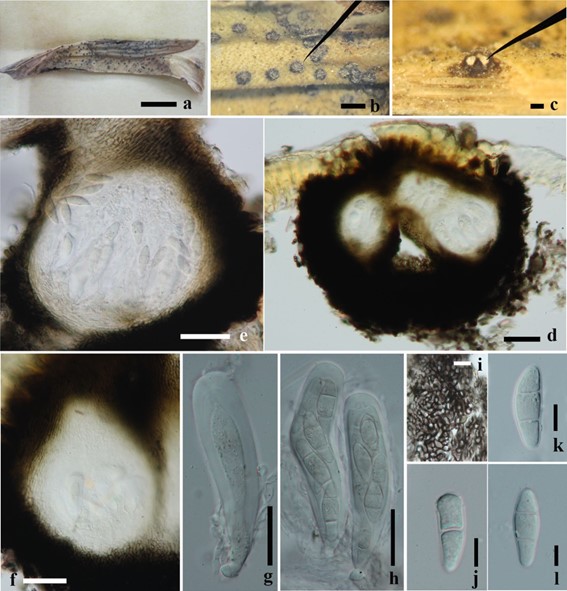Kellermania yuccifoliorum A.W. Ramaley, Mycotaxon 47: 262 (1993).
MycoBank number: MB 360150; Index Fungorum number: IF 360150; Facesoffungi number: FoF 06691; Figs. 21 and 22
Description: see Monkai et al. (2013).
Material examined: USA, Califonia, San Bernardino County, Roadside 20 miles east of Baker (Hwy. 91/466), on leaves of Yucca brevifolia Engelmann, 14 April 1960, Isabelle Tavares No. 466 (UC 1202973, holotype of Planistromella yuccifoliorum).
Notes: The type species of Kellermania (K. yuccifoliorum ≡ Planistromella yuccifoliorum) differs from other genera in Planistromellaceae in having 1–2-septate ascospores (Ramaley 1993; Barr 1996). The asexual morph of K. yuccifoliorum is characterized by uniloculate conidiomata, which develops in the same stroma as the ascogenous locules and 2-septate conidia with a unique apical appendage (Ramaley 1993).

Fig. 21 Kellermania yuccifoliorum (UC 1202973, holotype of P. yuccifoliorum). a, b Ascostromata on the host surface. c, d Section of ascostroma. e, f Ascoma. g Immature ascus. h Mature asci. i Cells of ascostroma. j Immature ascospore. k, l Mature ascospores. Scale bars: a = 1 cm, b = 1000 µm, c = 200 µm, d = 100 µm, e, f = 50 µm, g, h = 30 µm, i = 20 µm, j–l = 10 µm

Fig. 22 Kellermania yuc- cifoliorum (redrawn from Ramaley 1993). a Conidioma. b Microconidia. c Spermatia and spermatiogenesis. d Conidio- genesis and origin appearance of apical appendage. e Conidia. Scale bars: a = 80 µm, b, d = 27 µm, e = 40 µm
Species
